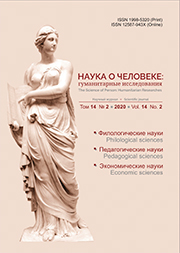V. A. Bogdanov
Integrated Social Service Center for the Population “Lyubava” of the Soviet Administrative District, Omsk, Russian Federation
Staffing support problem in complex social service centers performing social and educational activities with minors being in a socially dangerous situation
Abstract: The article is devoted to the problem of effective organization of social and pedagogical activities with minors being in a socially dangerous situation in the conditions of complex social service centers. The purpose of the article is to show that having limited pedagogical personnel resources, it is possible to qualitatively organize social and pedagogical activities with minors who are in a socially dangerous situation, if student interns of pedagogical universities are considered as a potential pedagogical personnel resource. The research is carried out on the basis of survey methods, socio-pedagogical design, and observation. Results consist in confirmation of the prospects of the idea of using student trainees as a pedagogical resource for socio-pedagogical activities with minors in a socially dangerous situation in the conditions of integrated social service centers. Conclusions are drawn about the expediency of organizing students’ practical training in integrated social service centers, the need for joint planning of social and pedagogical activities, based on the interests of all concerned parties: integrated social service centers, institutions of higher and professional education, as well as minors in a socially dangerous situation.
Keywords: complex social service centers, minors in a socially dangerous situation, social and pedagogical activities, specialist in family work; specialist in social work, student interns; industrial practice, potential human resource.
Paper submitted: August 9, 2021.
For citation: Bogdanov V. A. (2022). Staffing support problem in complex social service centers performing social and educational activities with minors being in a socially dangerous situation. Russian Journal of Social Sciences and Humanities, vol. 16, no. 1, pp. 140–148. DOI: 10.17238/issn1998-5320.2022.16.1.16.

